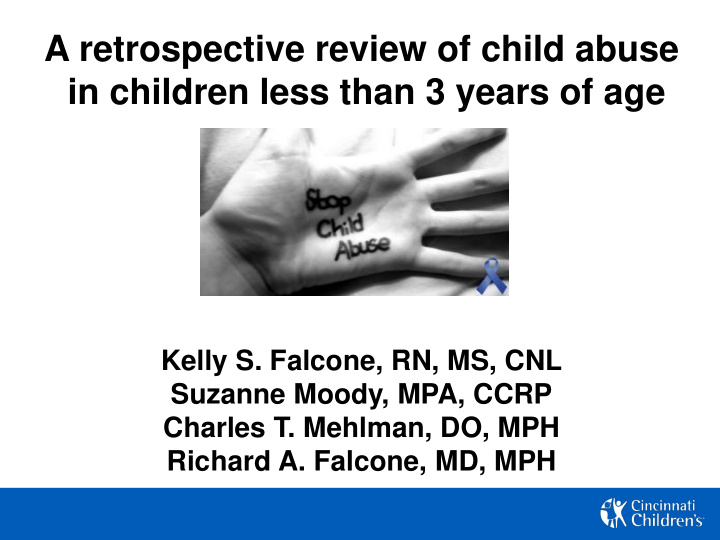



A retrospective review of child abuse in children less than 3 years of age Kelly S. Falcone, RN, MS, CNL Suzanne Moody, MPA, CCRP Charles T. Mehlman, DO, MPH Richard A. Falcone, MD, MPH
Disclosures • We have no conflict of interest or financial to disclose related to this presentation.
Background • Non-accidental trauma remains a significant public health issue • Consequences of missed opportunities can be fatal • National screening guidelines do exist • Data exists that adherence to guidelines is variable and potentially biased
Guideline Comparison AAP AAOS Children younger than thirty- Provides information and six months, with a recommendations to help diaphyseal femur fracture, guide the provider in should be evaluated for identifying potential abusive child abuse injuries in children; however ultimately leaves the decision to screen for abuse up to the individual.
Guideline Comparison WOOD et al. • Multi-disciplinary expert consensus • Defines injuries based on age • Screening without bias • Accounts for injuries in ambulating/cruising children
Purpose Compare the screening patterns of children, that presented to our institution with fractures, to the recommendations of these three nationally recognized guidelines
Methods • Retrospective review of the registry from our Level 1 Pediatric Trauma Center • Children ≤ 3 years, evaluated for isolated orthopaedic fractures in 2014 – ≤ 2 years with any fracture – Between 2-3 years with a femur fracture • Performance of skeletal survey was recorded as a marker of screening
Demographics N = 269 Age (mean) 16 months Gender Male 126 (46.8) Female 143 (53.2) Race White 176 (65.7) African American 50 (18.7) Other 42 (15.7) Insurance Status Government 123 (45.7) Private 146 (54.3)
Screening Compliance AAP AAOS Wood 269 13 52 Eligible Patients 28 (10.4) 9 (69.2) 28 (53.8) Screened 241 (89.6) 4 (30.8) 24 (46.2) Not Screened
Screened/Unscreened Screened Not Screened Gender Male 12 (42.9) 11 (32.4) Female 16 (57.1) 23 (67.7) Race White 15 (53.6) 24 (70.6) African American 8 (28.6) 2 (5.9) Other 5 (17.9) 8 (23.5) Insurance Status Government 17 (60.7) 13 (38.2) Private 11 (39.3) 21 (61.8)
In Conclusion… • According to the AAP guideline we potentially missed screening in 90% A single, well-defined • According to the AAOS, screening was screening guideline is missed in 30% • According to Wood, screening was missed recommended in 46% • Inconsistent application led to disparate screening patterns
What Now… • Create a uniform guideline for use in Emergency/Urgent Care Departments (PTS) • Conduct a multicenter, prospective study of this guideline to determine how to achieve optimal results • Collect injury data from outside facilities (non-child abuse centers) to determine appropriate follow up care • Creation of a database (based on area/national) of noted suspicion • Develop guideline for out-patient department screening
Questions…. Kelly.Falcone@cchmc.org
References • http://quickfacts.census.gov/qfd/states/39/3915000.html • http://www.acf.hhs.gov/sites/default/files/cb/cm2013.pdf#page=31 • http://www.cdc.gov/violenceprevention/childmaltreatment/ • AAOS Guideline on The Treatment of Pediatric Diaphyseal Femur Fractures • http://pediatrics.aappublications.org/content/119/6/1232.full
Recommend
More recommend